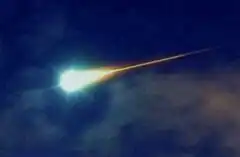

A bolide is normally taken to mean an exceptionally bright meteor, but the term is subject to more than one definition, according to context. It may refer to any large crater-forming body, or to one that explodes in the atmosphere. It can be a synonym for a fireball, sometimes specific to those with an apparent magnitude of −14 or brighter.
Definitions
The word bolide (/ˈboʊlaɪd/; from Italian via Latin, from Ancient Greek βολίς (bolís) 'missile'[2][3]) may refer to somewhat different phenomena depending on the context in which the word appears, and readers may need to make inferences to determine which meaning is intended in a particular publication.
One sense refers to an extremely bright meteor, especially one that explodes in the atmosphere. In astronomy, it refers to a fireball about as bright as the full moon, and it is generally considered a synonym for a fireball. In geology, a bolide is a very large impactor.
One definition describes a bolide as a fireball reaching an apparent magnitude of −14 or brighter – more than twice as bright as the full moon.[4] Another definition describes a bolide as any generic large crater-forming impacting body whose composition (for example, whether it is a rocky or metallic asteroid, or an icy comet) is unknown.[5]
A superbolide is a bolide that reaches an apparent magnitude of −17 or brighter,[4][6] which is roughly 100 times brighter than the full moon. Recent examples of superbolides include the Sutter's Mill meteorite in California and the Chelyabinsk meteor in Russia.
Astronomy
_-_Meteorite.gif)
The IAU has no official definition of "bolide", and generally considers the term synonymous with fireball, a brighter-than-usual meteor; however, the term generally applies to fireballs reaching an apparent magnitude −14 or brighter.[4] Astronomers tend to use bolide to identify an exceptionally bright fireball, particularly one that explodes (sometimes called a detonating fireball).[7] It may also be used to mean a fireball that is audible.
Superbolide
Selected superbolide air bursts:
- Tunguska event (Russia, 1908)
- 2009 Sulawesi superbolide (Indonesia, 2009)
- Chelyabinsk meteor (Russia, 2013)
Geology
Geologists use the term bolide differently from astronomers. In geology, it indicates a very large impactor. For example, the Woods Hole Coastal and Marine Science Center of the USGS uses bolide for any large crater-forming impacting body whose origin and composition is unknown, as, for example, whether it was a stony or metallic asteroid, or a less dense, icy comet made of volatiles, such as water, ammonia, and methane.[5]
The most notable example is the bolide that caused the Chicxulub crater 66 million years ago. Scientific consensus agrees that this event directly led to the extinction of all non-avian dinosaurs, and it is evidenced by a thin layer of iridium found at that geological layer marking the K–Pg boundary.
Gallery
See also
References
- ↑ "We are not Alone: Government Sensors Shed New Light on Asteroid Hazards". Universe Today. Retrieved 12 April 2015.
- ↑ "bolide". Merriam-Webster.com Dictionary.
- ↑ "bolide". Oxford English Dictionary (Online ed.). Oxford University Press. (Subscription or participating institution membership required.)
- 1 2 3 Belton, MJS (2004). Mitigation of hazardous comets and asteroids. Cambridge University Press. ISBN 0521827647.: 156
- 1 2 "Introduction: What is a Bolide?". Woodshole.er.usgs.gov. 1 April 1998. Retrieved 16 September 2011.
- ↑ Adushkin, Vitaly; Ivan Nemchinov (2008). Catastrophic events caused by cosmic objects. Springer. ISBN 978-1402064524.: 133
- ↑ bolide. Oxford University Press. 2018. ISBN 978-0191851193. Retrieved 1 September 2019.
{{cite book}}:|work=ignored (help)
External links
- historic record of bolides that have been witnessed entering the Earth’s atmosphere around the world from 861 through 2012 (B612 Foundation)
- Bolide Events from 1988 to the present neo.jpl.nasa.gov
- Earth Impact Effects Program Estimates crater size and other effects of a specified body colliding with Earth.
